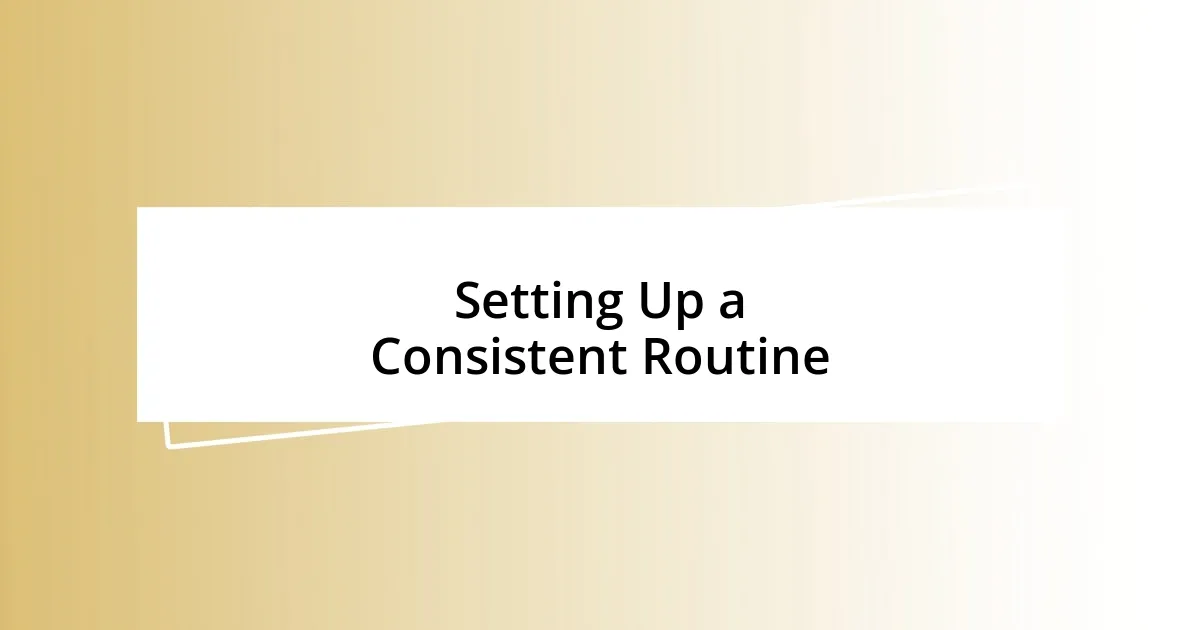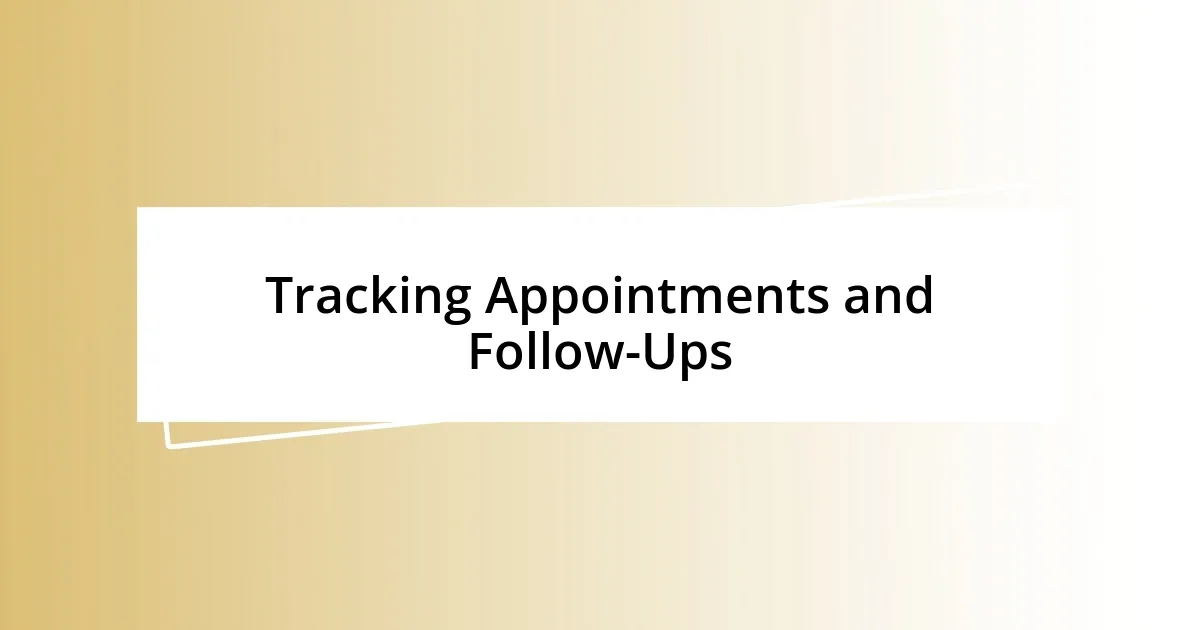Key takeaways:
- Organization creates a sense of calm and control, enhancing overall productivity and reducing stress.
- Utilizing tech tools like Calendly and Google Calendar streamlines scheduling and makes appointment management easier.
- Establishing a consistent routine and using calendar management techniques like time blocking increases focus and order in daily life.
- Effective online communication and regular follow-ups strengthen professional relationships and ensure accountability for tasks.

Understanding the Importance of Organization
When I think about organization, I often remember a particularly chaotic time in my life—running from work meetings to doctor appointments without a moment to breathe. It was overwhelming. I couldn’t help but wonder: how could I have made things easier for myself? Being organized isn’t just about making life manageable; it’s about fostering a sense of calm that allows us to focus on what truly matters.
I’ve learned that organization serves as the backbone of our daily routines. Imagine trying to juggle multiple appointments without a clear system in place. It’s like trying to balance on a tightrope—one small misstep can lead to falling into a confusing mess of missed meetings and stress. The emotional toll this takes can be exhausting.
Reflecting on my experience, I find that being organized creates a ripple effect in other areas of my life. When I know where I need to be and when I need to be there, I feel empowered and in control. Have you ever felt that surge of confidence when everything falls into place? I’ve discovered that a little organization can transform chaotic days into productive ones, helping us embrace opportunities rather than merely surviving our schedules.

Tech Tools for Scheduling Appointments
Utilizing tech tools for scheduling has been a real game changer for me. I used to feel overwhelmed with back-and-forth emails, trying to coordinate times that worked for everyone involved. Now, with just a few clicks, I can see everyone’s availability, and it drastically reduces my stress levels. A straightforward tool can transform a scheduling nightmare into a smooth process. Here are some of my go-to tech tools that help me stay organized:
- Calendly: I love how it syncs with my calendar and automatically updates my availability. It’s as if I have a personal assistant!
- Google Calendar: This is a classic. I appreciate the reminders and the ability to color-code events. It makes my entire month visible at a glance.
- Doodle: Perfect for group meetings. It lets everyone weigh in on their preferred times, eliminating the guesswork.
- Acuity Scheduling: I find this particularly useful for booking appointments with clients. It allows for payment integration, which is a big plus in my professional life.
Incorporating these tools into my routine has not only streamlined my scheduling but has also freed up mental energy. I can focus on my actual appointments instead of worrying about fitting everything in. Honestly, I felt a sense of relief the first time I used one of these scheduling tools; the chaos of appointment planning was replaced with clarity. They’ve become essential for processing my daily life in a more organized way, helping me keep my priorities straight.

Setting Up a Consistent Routine
Setting up a consistent routine has been a lifeline for me amidst the whirlwind of online appointments. I remember one week when every day felt like a race against time. I made a simple decision: I would allocate specific slots for meetings and stick to them. Surprisingly, this minor change had a major impact. It was as if I’d charted a map through chaos, giving me a destination and a clearer path. That week, instead of scrambling, I felt a sense of calm and focus.
Another aspect of maintaining routine is the importance of consistency. I realized that by blocking specific days for particular types of appointments—like Tuesday mornings for personal calls and Thursday afternoons for work-related meetings—I transformed my schedule into a well-oiled machine. This approach wasn’t just another task; it became an anchor in my week. Have you ever noticed how a predictable rhythm can ease anxiety? Each appointment became something to look forward to rather than a burden, enhancing my overall mood and productivity.
Looking back, I wish I had embraced this idea sooner. Sticking to a routine prompts me to prepare more effectively for each appointment, making my interactions richer and more meaningful. There’s something reassuring about seeing a structured schedule in my calendar—that visual representation of order brings me peace. If you’ve found yourself overwhelmed, consider developing your own consistency. It can be a delightful revelation.
| Approach | Benefits |
|---|---|
| Blocking Time | Creates order and predictability in your schedule |
| Consistent Days | Enhances focus and reduces anxiety associated with busy schedules |

Utilizing Calendar Management Techniques
Utilizing calendar management techniques can truly elevate how I manage online appointments. For example, I used to let my calendar become a chaotic maze, with overlapping events and missed reminders. When I started using color-coding, I felt an immediate sense of relief. Each color now represents a different category of my life—work, personal, and family. It’s amazing how that simple visual cue has helped me prioritize and distinguish my commitments at a glance.
One technique that has consistently worked for me is the “time blocking” method. I carve out dedicated slots for specific tasks or meetings in my calendar. It’s like creating a strategic blueprint for my day. I remember a particularly busy week when I tried this approach. Instead of hopping from one meeting to another, I focused intently on each task within its allotted block. It transformed my productivity and reminded me how powerful it is to give each commitment the attention it deserves. Isn’t it surprising how just a little structure can lead to profound clarity?
Additionally, I also embrace regular reviews of my calendar. At the end of each week, I set aside a few minutes to reflect and adjust as needed. This practice allows me to stay flexible while maintaining control. I often ask myself, “What worked this week? What didn’t?” This simple habit not only keeps my appointments organized but also fosters a mindset of continuous improvement. When I take the time to reassess and adapt, I feel more in tune with my schedule, making it easier to stay focused and proactive.

Best Practices for Online Communication
Effective online communication is essential for keeping appointments organized, and it starts with being clear and concise. I’ve learned that something as simple as sending an agenda ahead of time can make a world of difference. When participants know what to expect, it reduces confusion and sets a positive tone. Do you ever find yourself lost in a meeting with no clear direction? By providing a clear path, I’ve found that conversations flow better and lead to more productive outcomes.
Engaging actively during virtual meetings also contributes significantly to effective communication. I remember once, during a crucial project discussion, I decided to take notes in real-time. As I listened, jotting down key points not only kept me engaged but also allowed me to ask pertinent questions. It truly transformed the dynamic of the conversation. Have you experienced the difference when everyone is actively participating? It fosters collaboration and ensures everyone is on the same page.
Lastly, I’ve realized the importance of follow-up communication after meetings. Sending a brief summary or action items can help solidify what was discussed and clarify responsibilities. I’ve built a habit of crafting these messages right after our discussions, which not only reinforces what we accomplished but also shows respect for everyone’s time. Don’t you find that a little reminder can keep motivation high? This small practice has been instrumental in helping me stay organized and accountable, ensuring that nothing slips through the cracks.

Tracking Appointments and Follow-Ups
Tracking appointments and follow-ups is essential in my organization routine. I often rely on digital tools that allow me to create reminders not just for meetings, but also for crucial follow-up tasks. For instance, I remember a time when I completely overlooked a follow-up email after an important client meeting—what a panic that was! Since then, I’ve set up automatic reminders, and now, those little alerts feel like a safety net that keeps my professional relationships thriving.
Regularly updating my appointment log has also been a game changer. I take a few moments at the end of each day to jot down notes about what transpired in my meetings. This habit provides me with a repository of insights that I can reference later, which is particularly helpful for follow-ups. Have you ever found yourself scrambling to remember what was discussed? I was there too, and trust me, it’s stressful! Now, I feel in control, and I can refer back to my notes to ensure every important detail is addressed.
I’ve learned that checking in with people after appointments can make all the difference. I try to personalize my follow-ups, even sending a quick message to ask how a project is progressing or if they need anything else from me. This simple gesture helps build rapport and shows that I genuinely care about the outcome. Oddly enough, reconnecting like this often leads to unexpected opportunities. Have you experienced that before? I think it’s a wonderful reminder that taking a few extra moments to connect can yield significant benefits in the long run.

Evaluating Your Organization System
Evaluating your organization system can truly be enlightening. I remember a moment when I realized my calendar was overloaded with appointments but lacked structure. It was overwhelming, and I could hardly keep track of what was truly priority. Have you ever felt buried under your own system? In that realization, I knew I had to simplify my approach.
One effective strategy for me has been regularly assessing the efficiency of my tools. I take a step back every month to evaluate what’s working and what isn’t. For example, I once switched from a bulky appointment book to a streamlined digital calendar that syncs with my devices. The transition was surprisingly satisfying! In what ways have you adjusted your tools for better organization? Finding what resonates with you can dramatically boost productivity.
Another aspect I focus on is ensuring that my organization method aligns with my daily routine. Last summer, after a particularly chaotic few weeks of missed calls and forgotten tasks, I rearranged how I prioritize my appointments. I learned that blocking specific times for critical tasks, rather than leaving things to chance, makes all the difference. Have you tried designating “focus times” in your schedule? Adapting your organization system to suit your lifestyle can lead to a more balanced and less stressful day.














